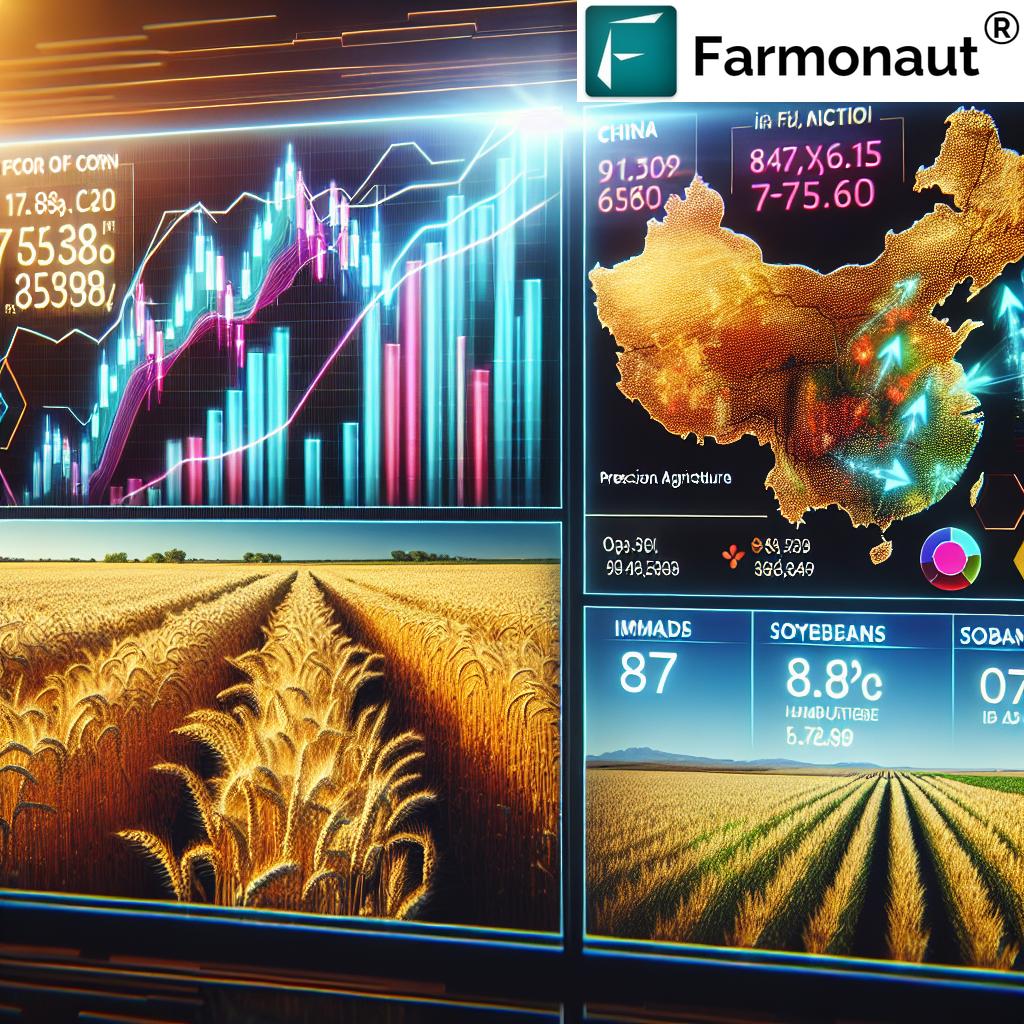US Grain Market Soars: Weather Impacts Corn and Wheat Futures as China Boosts Soybean Demand
“Corn futures have climbed to a near one-year high, while spring wheat prices surge towards a two-year peak.”
Welcome to our comprehensive analysis of the current US grain market trends. In this blog post, we’ll explore the fascinating dynamics shaping the agricultural commodity landscape, focusing on corn, wheat, and soybean markets. As we delve into the intricate world of grain futures and agricultural weather impacts, we’ll uncover how these factors are influencing global food supply chains and creating new opportunities for farmers and investors alike.
At Farmonaut, we’re committed to providing cutting-edge precision agriculture solutions that help farmers navigate these challenging market conditions. Our satellite-based crop monitoring technology and AI-driven insights empower agriculturists to make informed decisions, optimize yields, and adapt to ever-changing market demands.

The Perfect Storm: Weather Challenges and Market Volatility
The US grain market is currently experiencing a perfect storm of factors that are driving prices to new heights. Let’s break down the key elements contributing to this surge:
- Corn Futures Climb: Corn futures have reached a near one-year high, reflecting growing concerns about crop stress and potential yield reductions.
- Spring Wheat Surge: Spring wheat prices are approaching a two-year peak, driven by weather-related worries in key growing regions.
- Soybean Demand: China’s robust appetite for soybeans continues to influence global markets, creating additional pressure on US grain supplies.
These market movements are not occurring in isolation. They are intricately linked to broader agricultural trends and weather patterns that are reshaping the industry landscape.
Agricultural Weather Impact: A Closer Look
Weather conditions play a crucial role in shaping grain market dynamics. This year, we’re seeing significant challenges in key agricultural regions:
- Northern Plains: Drought conditions are persisting, threatening spring wheat yields and quality.
- Midwest: Irregular rainfall patterns and temperature fluctuations are causing concern for corn and soybean crops.
- Southern States: Excessive moisture in some areas has delayed planting and could impact overall production.
These weather patterns are not just affecting current crop conditions; they’re also influencing futures markets as traders anticipate potential supply constraints.
Corn Futures: A Market on the Rise
Corn futures have been making headlines with their impressive climb to near one-year highs. Several factors are contributing to this upward trend:
- Weather Concerns: Dry conditions in key growing areas have raised fears about potential yield reductions.
- Global Demand: Increasing use of corn for ethanol production and animal feed is driving up demand.
- Export Expectations: Anticipated increases in US corn exports are adding bullish sentiment to the market.
For farmers utilizing Farmonaut’s precision agriculture solutions, staying ahead of these market trends is crucial. Our satellite-based crop monitoring can help identify potential stress areas early, allowing for timely interventions to protect yields.
Spring Wheat: A Market Reaching New Heights
The spring wheat market is experiencing its own surge, with prices approaching two-year peaks. Key drivers include:
- Drought Impact: Persistent dry conditions in the Northern Plains are threatening crop quality and quantity.
- Global Supply Concerns: Reduced production in other wheat-exporting countries is putting pressure on US supplies.
- Quality Premium: High-protein spring wheat is in particular demand, commanding premium prices.
Farmers in wheat-growing regions can benefit from Farmonaut’s advanced crop monitoring tools to assess field conditions and make data-driven decisions about irrigation and nutrient management.
Soybean Market: China’s Influence and Global Demand
The soybean market continues to be heavily influenced by Chinese demand. Here’s what you need to know:
- Strong Import Demand: China’s robust appetite for soybeans is supporting global prices.
- US Export Opportunities: American farmers are well-positioned to meet this demand, potentially boosting exports.
- Weather Uncertainties: Like corn, soybean crops are facing weather-related challenges that could impact yields.
Farmonaut’s AI-powered advisory system can help soybean farmers optimize their crop management strategies to meet this growing demand while navigating uncertain weather conditions.
Commodity Price Forecasting: Tools and Strategies
Accurate commodity price forecasting is essential for farmers, traders, and agribusinesses. Here are some key tools and strategies:
- Technical Analysis: Studying price charts and patterns to identify potential market trends.
- Fundamental Analysis: Examining supply and demand factors, weather patterns, and global economic conditions.
- Machine Learning Models: Utilizing AI-driven algorithms to process vast amounts of data and generate price predictions.
Farmonaut’s data-driven insights can complement these forecasting methods by providing real-time information on crop health and potential yield estimates.
“China’s strong soybean demand is significantly influencing global grain market dynamics, affecting US agricultural commodity prices.”
Grain Futures Trading Strategies in Volatile Markets
With market volatility on the rise, traders and investors are adapting their strategies. Here are some approaches to consider:
- Spread Trading: Taking advantage of price differentials between different grain futures contracts.
- Options Strategies: Using puts and calls to manage risk and potentially profit from market movements.
- Weather Derivatives: Hedging against adverse weather conditions that could impact crop yields.
While Farmonaut doesn’t provide trading advice, our crop monitoring tools can offer valuable insights into potential supply fluctuations that may influence futures markets.
Agtech for Crop Yield Optimization: Farmonaut’s Approach
In these challenging market conditions, optimizing crop yields is more important than ever. Farmonaut’s precision agriculture solutions offer several key benefits:
- Satellite-Based Monitoring: Real-time insights into crop health and field conditions.
- AI-Driven Recommendations: Personalized advice on irrigation, fertilization, and pest management.
- Resource Optimization: Tools to help farmers reduce input costs while maximizing yields.
By leveraging these technologies, farmers can make data-driven decisions that improve their resilience to market fluctuations and weather challenges.
Explore Farmonaut’s API for advanced data integration
Crop Stress Monitoring: A Key to Market Success
Effective crop stress monitoring is crucial for anticipating potential yield impacts and making informed management decisions. Farmonaut’s technology offers several advantages:
- Early Detection: Identify potential issues before they become visible to the naked eye.
- Precise Interventions: Target problem areas with specific treatments to minimize crop losses.
- Historical Analysis: Compare current conditions to past seasons for better decision-making.
By staying ahead of crop stress issues, farmers can potentially mitigate the impacts of adverse weather and maintain stronger yields even in challenging conditions.
Global Agricultural Landscape: Broader Impacts
The current US grain market trends are part of a larger global agricultural picture. Here are some key international factors to consider:
- South American Production: Brazil and Argentina’s soybean and corn crops can significantly impact global supply and US export opportunities.
- European Union Policies: Changes in agricultural regulations and trade agreements can affect market dynamics.
- Middle East and North Africa: These regions are major wheat importers, and their demand can influence global prices.
Farmonaut’s global perspective and data-driven insights can help farmers and agribusinesses navigate these complex international market dynamics.
Access our API Developer Docs for seamless integration
Precision Agriculture: The Future of Farming
As markets become more volatile and weather patterns less predictable, precision agriculture is increasingly crucial. Farmonaut’s solutions offer:
- Data-Driven Decision Making: Use real-time insights to optimize farm management practices.
- Resource Efficiency: Reduce waste and improve sustainability through targeted interventions.
- Yield Forecasting: Better predict harvest outcomes to inform marketing and financial decisions.
By embracing these technologies, farmers can position themselves for success in even the most challenging market conditions.
Comparative Analysis of US Grain Market Trends
| Grain Type | Current Futures Price (est.) | Price Change (%) from Previous Year | Primary Weather Impact | Major Demand Factors | Projected Yield (est.) |
|---|---|---|---|---|---|
| Corn | $6.50/bushel | +15% | Drought in Midwest | Ethanol production, livestock feed | 175 bushels/acre |
| Wheat (Spring) | $8.75/bushel | +20% | Dry conditions in Northern Plains | Global supply concerns, quality premium | 45 bushels/acre |
| Soybeans | $14.25/bushel | +10% | Mixed conditions across growing regions | Strong Chinese demand, biofuel industry | 50 bushels/acre |
This table provides a snapshot of the current US grain market, highlighting the interplay between weather impacts, global demand, and price fluctuations. It’s clear that each grain type faces unique challenges and opportunities in the present market conditions.
Looking Ahead: Future Projections and Market Outlook
As we look to the future of the US grain market, several key trends and factors are likely to shape the landscape:
- Climate Change Adaptation: Farmers will need to increasingly rely on technology like Farmonaut’s solutions to adapt to changing weather patterns.
- Global Trade Dynamics: Ongoing negotiations and geopolitical factors will continue to influence export opportunities and price trends.
- Technological Innovation: Advancements in precision agriculture, including AI and satellite monitoring, will play a crucial role in optimizing yields and resource management.
- Sustainability Initiatives: Growing emphasis on sustainable farming practices may impact production methods and market preferences.
By staying informed and leveraging cutting-edge technologies, farmers and agribusinesses can position themselves for success in this evolving market landscape.
Conclusion: Navigating the Complexities of the US Grain Market
The US grain market is currently experiencing a period of significant volatility, driven by a complex interplay of weather challenges, global demand shifts, and technological advancements. Corn and wheat futures are reaching multi-year highs, while soybean markets continue to be heavily influenced by Chinese demand.
In this dynamic environment, precision agriculture solutions like those offered by Farmonaut are becoming increasingly crucial. By providing real-time crop monitoring, AI-driven insights, and resource optimization tools, we’re empowering farmers to make data-driven decisions that can improve yields, reduce costs, and navigate market uncertainties.
As we move forward, staying informed about market trends, leveraging advanced technologies, and adapting to changing conditions will be key to success in the agricultural sector. Whether you’re a farmer, trader, or agribusiness professional, the insights and tools discussed in this blog can help you navigate the complexities of the US grain market and position yourself for future success.

Frequently Asked Questions (FAQ)
- How are weather conditions affecting US grain markets?
Weather challenges, particularly drought in the Northern Plains and irregular rainfall in the Midwest, are causing concern for crop stress and potential yield reductions in corn, wheat, and soybean crops. This has led to increased futures prices for these commodities. - What role is China playing in the current soybean market?
China’s strong demand for soybeans is significantly influencing global grain market dynamics. Their robust import needs are supporting soybean prices and creating export opportunities for US farmers. - How can precision agriculture help farmers navigate current market conditions?
Precision agriculture tools, like those offered by Farmonaut, provide real-time crop monitoring, AI-driven insights, and resource optimization. These technologies help farmers make data-driven decisions to improve yields, reduce costs, and adapt to changing market and weather conditions. - What are some key strategies for grain futures trading in volatile markets?
Some strategies include spread trading to take advantage of price differentials, using options for risk management, and considering weather derivatives to hedge against adverse conditions. - How might climate change impact future US grain markets?
Climate change is likely to increase weather variability and extreme events, potentially leading to more frequent supply disruptions. This may result in greater price volatility and the need for advanced crop monitoring and management techniques.






